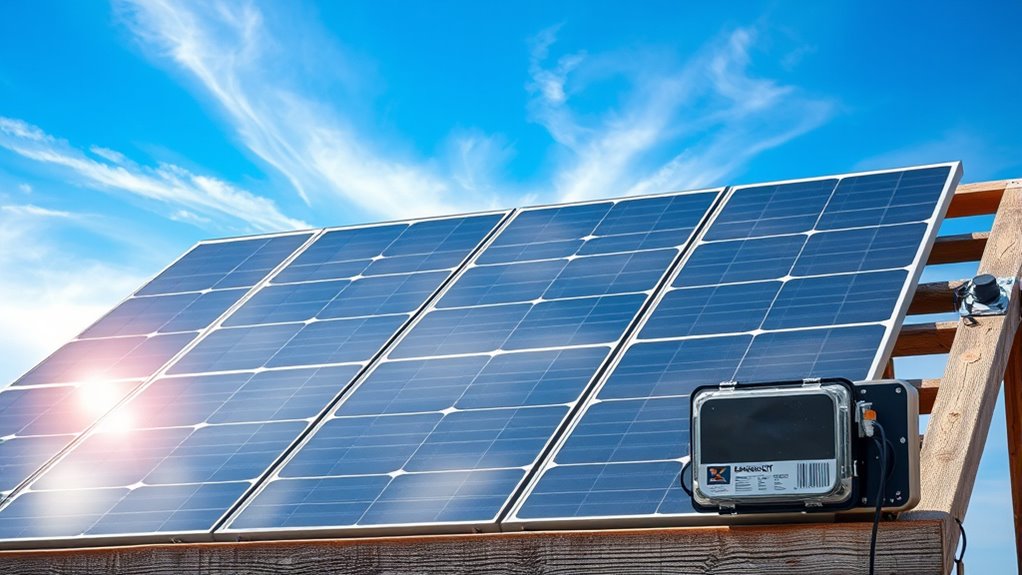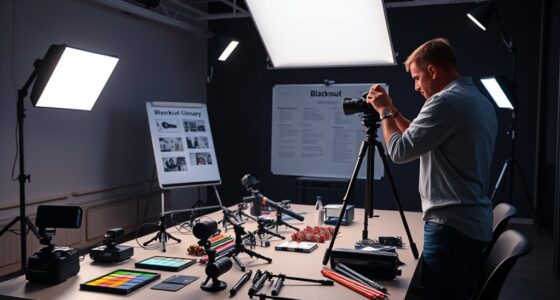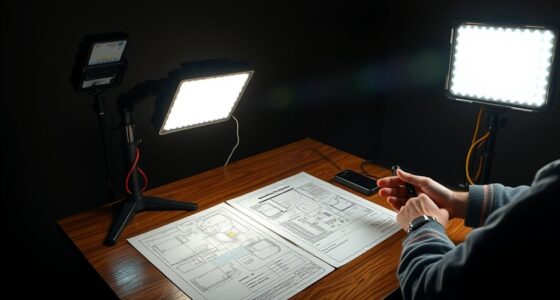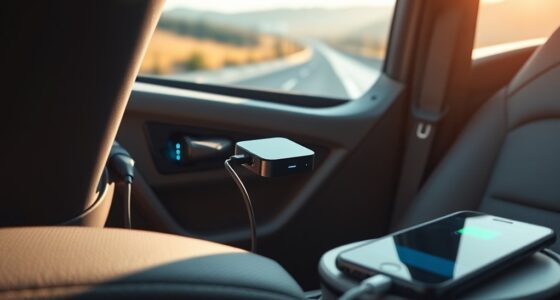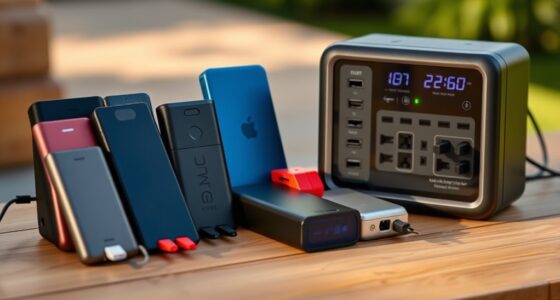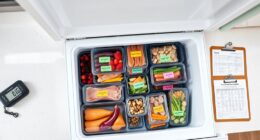To prepare for emergencies, understanding how solar panels work is essential. Sunlight hits the panels, exciting electrons in the silicon cells, creating direct electricity. You can choose between portable, fixed, off-grid, or grid-tied systems based on your needs. Proper installation maximizes sunlight exposure, and ongoing maintenance keeps your system reliable. Learning these basics helps you make smart choices for energy independence. Keep going to discover detailed tips for setting up, maintaining, and optimizing your solar system during power outages.
Key Takeaways
- Understand how solar panels convert sunlight into electricity through photovoltaic cells and the importance of efficiency and durability.
- Choose appropriate system types—portable, off-grid, or grid-tied—based on emergency needs and location.
- Properly install and position panels to maximize sun exposure, minimize shading, and adjust for seasonal sunlight changes.
- Regularly maintain and troubleshoot panels, batteries, and connections to ensure reliable power during emergencies.
- Optimize energy use with efficient devices, proper system planning, and cost-effective component selection for long-term preparedness.
How Solar Panels Capture and Convert Sunlight
Have you ever wondered how solar panels turn sunlight into electricity? It all begins with solar radiation, which hits the surface of your panel. Inside, photovoltaic cells—made of silicon—absorb this sunlight. When sunlight strikes these cells, it excites electrons, creating an electric current. This process, called the photovoltaic effect, directly converts solar energy into usable electricity. The more sunlight your panel receives, the more electricity it produces. These cells are specially designed to maximize absorption and efficiency. As sunlight continues to hit the cells, they generate a flow of electrons, which flows through wires to power your devices or charge batteries. Understanding this process helps you appreciate how solar panels harness the sun’s energy and turn it into clean, renewable power. Efficiency of photovoltaic cells plays a crucial role in the overall performance of solar energy systems.
Types of Solar Panel Systems for Emergency Use
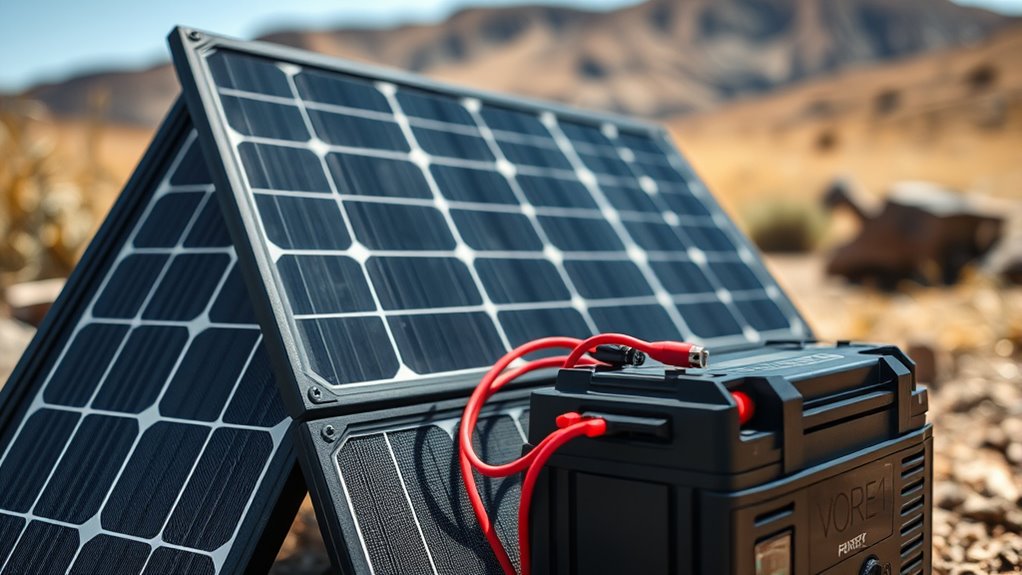
When choosing a solar panel system for emergencies, you’ll need to consider whether a portable or fixed setup best fits your needs. You should also decide if an off-grid system, which operates independently, or a grid-tied system, which connects to the main power grid, is more suitable. Understanding these options helps make certain you have reliable power during emergencies. Additionally, selecting a system with high energy efficiency can maximize power output and ensure better performance during critical situations.
Portable vs. Fixed Systems
Choosing between portable and fixed solar panel systems depends on your emergency needs and circumstances. Portable systems offer flexibility, letting you move power sources where you need them most. Fixed installations provide a reliable, hands-off energy solution, ideal for long-term setup. Consider these key points:
- You can quickly deploy portable systems during a crisis, ensuring immediate power.
- Fixed installations deliver consistent energy, reducing the need for constant adjustments.
- Portable systems are perfect for outdoor adventures or temporary shelters.
- Fixed setups are better for establishing a permanent emergency power backup.
- Understanding solar panel types and their features can help you select the best system for your needs.
Your decision hinges on whether you prioritize mobility or stability. Both options serve essential roles in emergencies, so choose wisely based on how you plan to use your solar power during crises.
Off-Grid vs. Grid-Tied
Selecting the right type of solar system depends on your specific emergency needs and how you plan to use the power. Off-grid systems operate independently, with batteries providing storage and system integration for backup power. They’re ideal if you need reliable, standalone energy. Grid-tied systems connect to the main power grid, allowing excess energy to feed back, but typically lack battery management for storage. This setup suits emergencies where grid access is temporarily unavailable but not critical. Consider this comparison:
| Feature | Off-Grid | Grid-Tied |
|---|---|---|
| Battery Management | Essential for storage | Optional, usually absent |
| System Integration | Fully standalone | Connects to the grid |
| Emergency Use | High independence | Limited during outages |
| Cost | Generally higher | Usually cheaper |
Choose based on your need for independence and backup reliability. Additionally, evaluating the cost-effectiveness of each system can help determine the best option for your situation.
Factors to Consider When Selecting Solar Panels
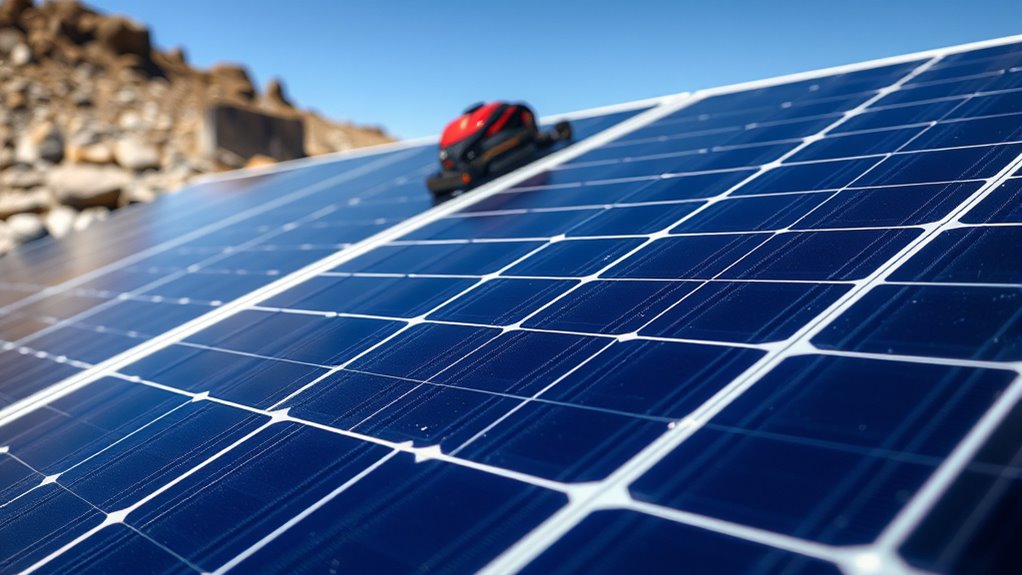
Understanding the key factors behind solar panel options can help you make smarter decisions for your energy needs. When selecting panels, consider these crucial aspects:
- Panel durability – Make certain your panels can withstand harsh weather conditions, especially during emergencies.
- Cost considerations – Balance upfront costs with long-term savings and efficiency.
- Efficiency ratings – Higher efficiency means more power in less space, essential during limited emergency setups.
- Warranty coverage – A solid warranty offers peace of mind for long-term reliability.
- Material quality – Selecting high-quality materials can enhance the lifespan and performance of your panels, especially important in emergency scenarios. Material quality
Setting Up a Solar Power System in Emergency Situations
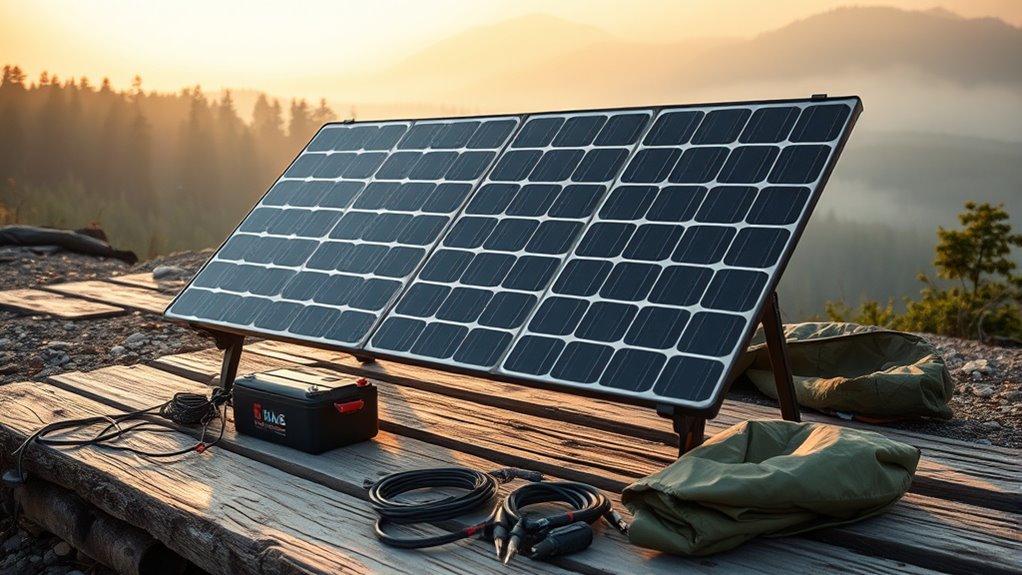
Setting up a solar power system for emergency situations requires careful planning to guarantee reliable energy when you need it most. First, focus on emergency preparedness planning by selecting durable, portable solar panels suited for quick deployment. Proper solar panel installation ensures safety and efficiency. Think about your power needs and location, and store essential equipment like batteries, inverters, and connectors. Use the table below to help visualize key considerations:
| Aspect | Details | Tips |
|---|---|---|
| Panel Type | Portable or fixed | Choose based on mobility |
| Location | Shaded vs. sun-exposed | Maximize sun exposure |
| Storage | Batteries for backup | Keep charged and accessible |
| Safety Measures | Secure installation | Avoid storms or damage |
Thorough planning and understanding of solar panel basics can significantly enhance your emergency preparedness. Thoughtful setup guarantees resilience when emergencies strike.
Maintaining and Troubleshooting Your Solar Panels

Regular maintenance and troubleshooting are essential to keep your solar panels operating at peak efficiency. By performing regular cleaning maintenance, you prevent dirt, dust, and debris from blocking sunlight. Troubleshooting techniques help you quickly identify and fix issues before they worsen. Here are four key steps:
- Visually inspect panels for dirt, shading, or damage.
- Clean your panels gently with water and a soft brush to remove grime.
- Check wiring and connections for corrosion or loose fittings.
- Use a multimeter to test voltage and ensure proper functioning.
- Stay informed about automation technologies that can assist in monitoring system performance remotely.
Staying proactive with these steps keeps your system running smoothly, saves energy, and extends your panels’ lifespan. Address problems early, and your solar setup will serve you reliably during emergencies.
Practical Tips for Maximizing Solar Energy During Power Outages

To make the most of your solar energy during power outages, start by optimizing your panel positioning for maximum sunlight exposure. Using energy-efficient devices reduces your power needs, helping your system last longer. Don’t forget to maintain your battery storage to guarantee you have reliable backup power when you need it most. Regularly inspecting your system ensures optimal performance and longevity.proper maintenance practices
Optimize Panel Positioning
Maximizing your solar energy output during power outages hinges on properly positioning your panels. Start by adjusting mounting angles to catch the most sunlight; a steeper angle often captures more during winter, while a shallower angle works well in summer. Next, consider shading considerations—avoid trees, buildings, or debris that cast shadows during peak sunlight hours. Here are key tips:
- Ensure panels face true south (or north, if in the southern hemisphere) for maximum exposure.
- Tilt panels at an ideal angle based on your latitude.
- Clear obstructions that cause shading during midday.
- Regularly check for snow, leaves, or dirt that can block sunlight.
- Be aware that cost and budgeting factors, such as the quality of materials and installation, can influence your overall system efficiency and effectiveness.
Implementing these steps guarantees you harness the full potential of your solar setup when you need it most.
Use Energy Efficient Devices
During a power outage, using energy-efficient devices can make a considerable difference in how long your solar energy lasts. Switch to energy-saving appliances and low wattage gadgets that consume minimal power. These devices help conserve your stored solar energy, ensuring you can run essential electronics longer. For example, replace traditional incandescent bulbs with LED lights, and opt for laptops or tablets over desktop computers. Avoid high-power appliances like space heaters or full-sized refrigerators if possible. Instead, focus on small, efficient devices that meet your immediate needs. By consciously choosing energy-efficient devices, you extend your solar power’s runtime, making your emergency setup more effective and sustainable. Incorporating high contrast ratios into your projector setup can also optimize your viewing experience during power outages, especially in dark environments. Small adjustments now can considerably improve your energy management during critical moments.
Maintain Battery Storage
Maintaining your battery storage is essential for making the most of your solar energy during outages. Proper battery maintenance ensures your storage capacity stays reliable when you need it most. Here are four tips to maximize your battery life:
- Regularly check and clean battery terminals to prevent corrosion.
- Keep batteries at ideal charge levels—avoid overcharging or deep discharges.
- Store batteries in a cool, dry place to prevent capacity loss from heat.
- Monitor battery health with periodic testing to catch issues early.
Frequently Asked Questions
How Long Do Solar Panels Typically Last During Emergencies?
During emergencies, solar panels typically last 25 to 30 years, depending on their quality and maintenance. Their lifespan can be affected by weather, debris, and proper upkeep, so regular inspections are crucial for emergency preparedness. By maintaining your solar panels well, you guarantee they continue to generate power when you need it most, providing reliable energy during crises and extending their effective lifespan.
Can Solar Panels Operate Effectively in Cloudy or Rainy Conditions?
Yes, solar panels can operate effectively in cloudy or rainy conditions, but their efficiency drops. Cloudy efficiency decreases because less sunlight reaches the panels, reducing power output. Rainy performance is also affected, though rain can help clean the panels, slightly improving efficiency afterward. To maximize energy during such conditions, choose high-quality panels and consider a larger system to compensate for reduced sunlight, ensuring you stay powered even in less ideal weather.
What Safety Precautions Are Necessary When Installing Solar Panels in Emergencies?
When installing solar panels in emergencies, prioritize electrical safety by turning off power sources and avoiding wet conditions. Always wear personal protective equipment like insulated gloves and safety goggles to prevent shocks or injuries. Confirm proper grounding and secure connections to prevent hazards. Keep a fire extinguisher nearby, and work cautiously around electrical components. Following these safety precautions helps protect you while safely setting up your solar emergency power system.
Are Portable Solar Panels More Reliable Than Fixed Systems During Outages?
Portable solar panels can be more reliable during outages because of their durability and ease of transport, allowing you to keep power flowing even if your fixed system fails or is damaged. However, fixed systems generally offer greater stability and consistent energy output over time. Your choice depends on your emergency needs; portable options are flexible, while fixed systems provide steady, long-term reliability.
How Do I Store Excess Solar Energy for Long-Term Emergency Use?
You should store excess solar energy in batteries designed for long-term use, like deep-cycle or lithium-ion batteries. Use an energy management system to monitor and optimize storage, ensuring your batteries are charged efficiently and protected from overcharging or discharging. Regularly maintain and check your battery health. By doing so, you’ll have reliable power reserves during emergencies, maximizing your solar system’s effectiveness and longevity.
Conclusion
Now that you know the basics, setting up your emergency solar power system is a smart move—no need to summon a wizard from Middle-earth. Regular maintenance and troubleshooting keep your setup running smoothly, ensuring you stay powered during blackouts. Remember, with a little prep, you can harness the sun’s magic to keep your lights on when everything else goes dark. Stay savvy, and your solar system will be your trusty sidekick in any emergency!
